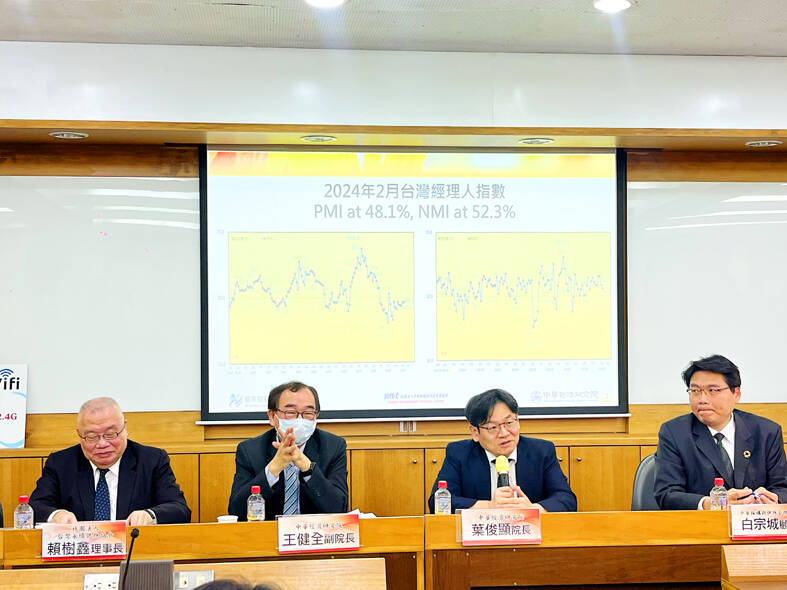Taiwan’s official manufacturing purchasing managers’ index (PMI) was 48.1 last month, virtually unchanged from January’s 48, as all sectors reported a decline in business mainly due to holiday disruptions, the Chung-Hua Institution for Economic Research (CIER, 中華經濟研究院) said yesterday.
However, firms were mostly confident about their business prospects, indicating that a rebound is around the corner, the institute said.
“The latest PMI showing is not bad given the significant drop in working days caused by the week-long Lunar New Year holiday in February,” CIER president Yeh Chun-hsien (葉俊顯) said.

Photo: Hsu Tzu-ling, Taipei Times
PMI data aim to gauge the health of the manufacturing industry, with scores of more than 50 indicating expansion and those lower than the threshold suggesting a contraction.
The barometer held steady, which was encouraging and had to do with expectations that business would pick up, Yeh said.
Order visibility might become clearer and boost purchasing activity from this month, he said.
Taiwan Semiconductor Manufacturing Co’s (台積電) recent opening of a wafer fab in Japan reflects an upturn in chip demand and would benefit the companies in its supply chain, he said.
At the same time, the six-month business outlook subindex gained 7.8 points to 54, returning to growth for the first time in 21 months, a sign that inventory adjustments for tech firms are close to ending, he said.
The surge in global demand for artificial intelligence (AI) is fueling local firms that supply AI severs, graphics processing units and other critical components, he added.
Holiday disruptions accounted for month-on-month declines in new orders, delivery time, employment, inventory and clients’ inventory, while industrial output and raw material prices increased, as firms prepared for improved business, the institute’s monthly report said.
The non-manufacturing index shed 1.2 points to 52.3 last month, because some sectors started to lose confidence as Taiwanese prefer to travel overseas and the number of inbound tourists is not growing fast enough, CIER said.
In particular, hotels and restaurants no longer held positive views about their business prospects due to the arrival of the low season and a high comparison base last year, it said.
However, financial institutions, property brokers and telecoms became optimistic, partly due to rallies on the TAIEX, it said.

Taiwan Semiconductor Manufacturing Co (TSMC, 台積電) last week recorded an increase in the number of shareholders to the highest in almost eight months, despite its share price falling 3.38 percent from the previous week, Taiwan Stock Exchange data released on Saturday showed. As of Friday, TSMC had 1.88 million shareholders, the most since the week of April 25 and an increase of 31,870 from the previous week, the data showed. The number of shareholders jumped despite a drop of NT$50 (US$1.59), or 3.38 percent, in TSMC’s share price from a week earlier to NT$1,430, as investors took profits from their earlier gains

In a high-security Shenzhen laboratory, Chinese scientists have built what Washington has spent years trying to prevent: a prototype of a machine capable of producing the cutting-edge semiconductor chips that power artificial intelligence (AI), smartphones and weapons central to Western military dominance, Reuters has learned. Completed early this year and undergoing testing, the prototype fills nearly an entire factory floor. It was built by a team of former engineers from Dutch semiconductor giant ASML who reverse-engineered the company’s extreme ultraviolet lithography (EUV) machines, according to two people with knowledge of the project. EUV machines sit at the heart of a technological Cold

Taiwan’s long-term economic competitiveness will hinge not only on national champions like Taiwan Semiconductor Manufacturing Co. (TSMC, 台積電) but also on the widespread adoption of artificial intelligence (AI) and other emerging technologies, a US-based scholar has said. At a lecture in Taipei on Tuesday, Jeffrey Ding, assistant professor of political science at the George Washington University and author of "Technology and the Rise of Great Powers," argued that historical experience shows that general-purpose technologies (GPTs) — such as electricity, computers and now AI — shape long-term economic advantages through their diffusion across the broader economy. "What really matters is not who pioneers

TAIWAN VALUE CHAIN: Foxtron is to fully own Luxgen following the transaction and it plans to launch a new electric model, the Foxtron Bria, in Taiwan next year Yulon Motor Co (裕隆汽車) yesterday said that its board of directors approved the disposal of its electric vehicle (EV) unit, Luxgen Motor Co (納智捷汽車), to Foxtron Vehicle Technologies Co (鴻華先進) for NT$787.6 million (US$24.98 million). Foxtron, a half-half joint venture between Yulon affiliate Hua-Chuang Automobile Information Technical Center Co (華創車電) and Hon Hai Precision Industry Co (鴻海精密), expects to wrap up the deal in the first quarter of next year. Foxtron would fully own Luxgen following the transaction, including five car distributing companies, outlets and all employees. The deal is subject to the approval of the Fair Trade Commission, Foxtron said. “Foxtron will be